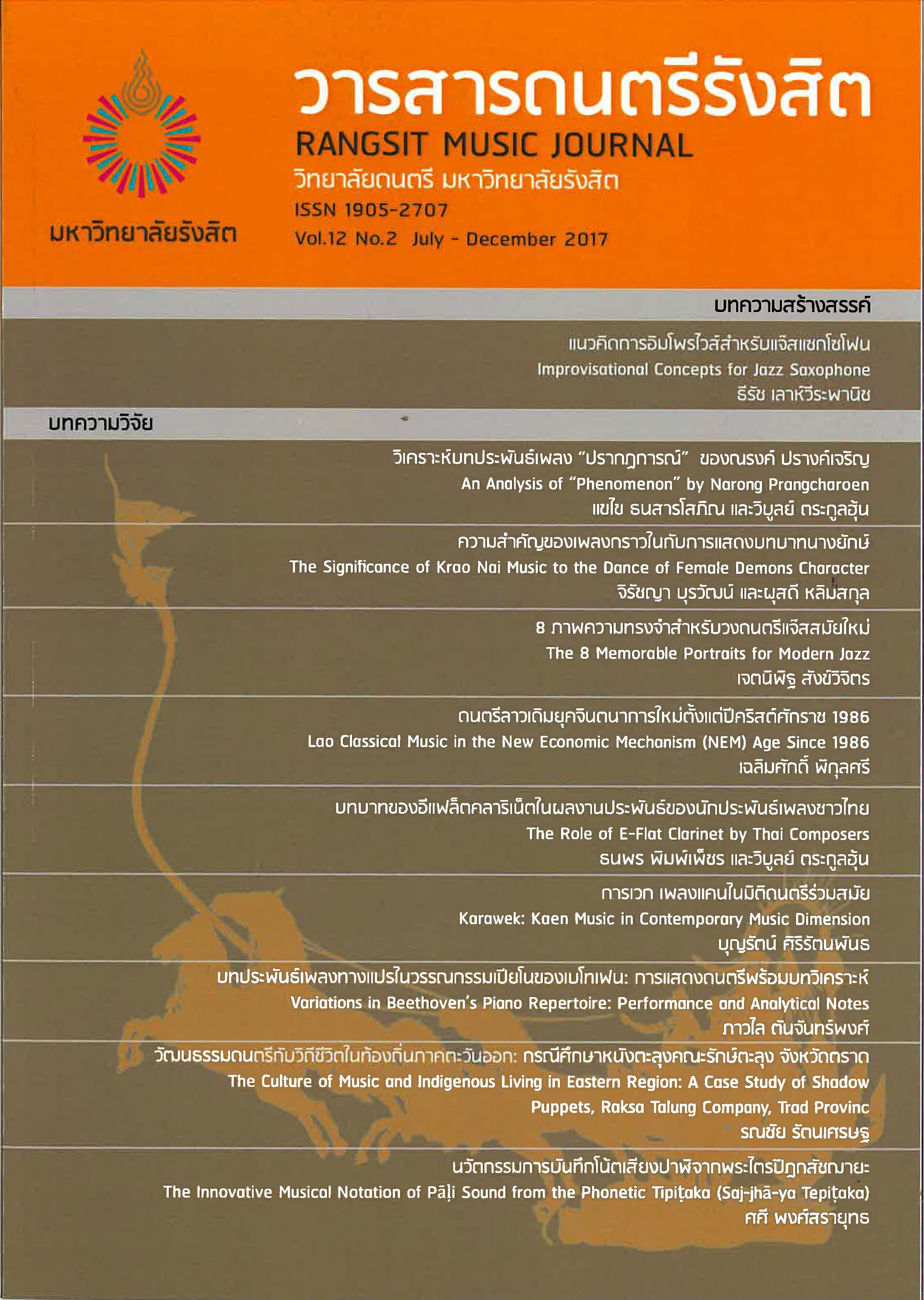The Significance of Krao Nai Music to the Dance of Female Demons Character
Keywords:
Krao Nai, Krao Female Demons, Giantesses in Khon and dance drama performanceAbstract
Krao Nai is an important musical piece from both musical and dance performance perspectives. From the musical performance perspective, it is one of the pieces in the Hom Rong Yen (evening overture) series with such distinctive tunes that it has been widely adapted as a solo piece for various musical instruments in both the Piphat and Khrueng Sai ensembles. Krao Nai is considered a highly-creative solo composition. The significance of Krao Nai originates from the fact that it is an elaboration of Naphat that Thai artists regard as Pleng Khru (music of the masters) or Pleng Chan Soong (advanced musical piece). From the dance performance perspective, Krao Nai is closely associated with the Khon and dance drama performances. It is one of the pieces in the Hom Rong (overture) series performed as an introduction to a dance performance. Krao Nai is also a Naphat piece for the dance performance of the demon characters, including Female Demons (Giantess) where the melodies and rhythms must be in tunes with the dance steps of these characters. Dancers must be familiar with the musical melodies and rhythms to be able to match their dance steps with the main or modified rhythms. As a rule, Krao Female Demons dance performance usually begins with an introductory narration about where a particular Female Demons character is heading to or what she is going to do, followed by a dance to Krao Nai music and ends with a dance to Pleng Cherd music. For a grandiose performance of Female Demons dance to the Krao Nai music, dancers must take into consideration the following dance fundamentals and techniques. The dancers must have: 1. Good leg strength; 2. Correct body postures; 3. Strong grip and competent handling of the accessory weapon; 4. Appropriate emotional expressions; and 5. A good ear for music in order to maintain rhythmic precision.
References
2. จิรัชญา บุรวัฒน์. “หลักการแสดงของนางศูรปนขาในละครดึกดำบรรพ์ เรื่อง รามเกียรติ์.” วิทยานิพนธ์ ศิลปศาสตรมหาบัณฑิต, สาขาวิชานาฏยศิลป์ไทย ภาควิชานาฏยศิลป์ คณะศิลปกรรมศาสตร์, จุฬาลงกรณม์หาวิทยาลัย, 2552.
3. ชนัสถ์นันท์ ประกายสันติสุข. “วิเคราะห์เดี่ยวซอด้วงเพลงกราวในทางครูแสวง อภัยวงศ์.” วิทยานิพนธ์ ศิลปศาสตรมหาบัณฑิต, สาขาวิชาดุริยางค์ไทย ภาควิชาดุริยางค์ไทย คณะศิลปกรรมศาสตร์, จุฬาลงกรณม์หาวิทยาลัย, 2552.
4. ธีระวุฒิ กลิ่นด้วง. “วิเคราะห์เดี่ยวระนาดเอกเพลงกราวใน : กรณีศึกษาครูชฏิล นักดนตรี.” วิทยานิพนธ์ศิลปศาสตรมหาบัณฑิต, สาขาวิชาดุริยางค์ไทย ภาควิชาดุริยางค์ไทย คณะ ศิลปกรรมศาสตร์, จุฬาลงกรณ์มหาวิทยาลัย, 2549.
5. พัชรินทร์ สันติอัชวรรณ. “ประวัตินางโขน.” วารสารดนตรีรังสิต 12, 1 (2560): 49-67.
6. สกลพัฒน ์โคตรตันติ. “วิเคราะห์เดี่ยวจะเข้เพลงกราวในทางครูนิภา อภัยวงศ์” วิทยานิพนธ์ตามหลักสูตรศิลปศาสตรมหาบัณฑิต, สาขาวิชาดุริยางค์ไทย ภาควิชาดุริยางค์ไทย คณะศิลปกรรมศาสตร์, จุฬาลงกรณ์มหาวิทยาลัย, 2554.







